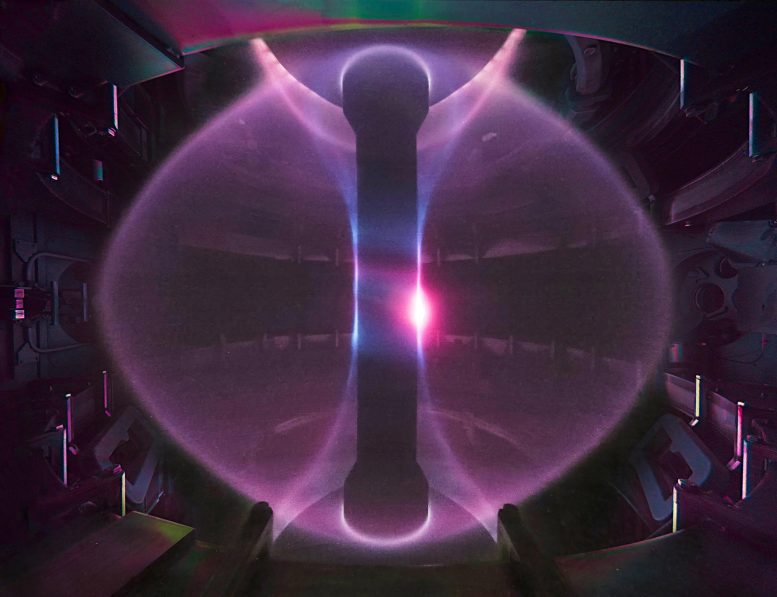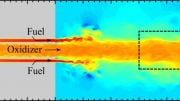
Image of the inside of a magnetic confinement experiment during plasma discharge. In a tokamak, plasma particles are confined and shaped by magnetic field lines that combine to act like an invisible bottle. Pictured, the spherical tokamak MAST at the Culham Centre for Fusion Energy (UK), where over 30,000 man-made ”stars” have been created. Photo: CCFE
What Is Plasma Confinement?
Plasma confinement refers to the containment of a plasma by various forces at the extreme conditions necessary for thermonuclear fusion reactions. These conditions exist naturally in stars, where they are sustained by the force of gravity. In the laboratory, researchers use strong magnetic fields to confine plasma. This magnetic confinement strategy may allow them to confine fusion grade plasmas over the long term. Another confinement strategy relies on the inertia of imploding matter. This inertial confinement strategy has been demonstrated on Earth in hydrogen bomb detonations and specialized facilities. Inertial confinement is an active research area. Laboratories use high power lasers or electrical discharges, to compress hydrogen fuel to very high densities for billionths of a second.
Plasma Confinement Facts
- Magnetically confined plasmas have achieved temperatures 10 times hotter than the core of our sun.
- ITER will be the first burning plasma in the world. It aims to generate 500 megawatts of fusion power–10 times more power than will be injected. NIF is the most energetic laser in the world with 2 megajoules of light energy (the energy consumed by 20,000 100-watt light bulbs in one second) delivered in 16 nanoseconds.
DOE Office of Science: Plasma Confinement Contributions
The Department of Energy Office of Science Fusion Energy Sciences program is the main source of support for magnetic plasma confinement research and development in the United States. Key among these efforts is DOE support for the ITER experiment. Once completed, ITER will be the first experiment to study confined nuclear fusion plasmas that can generate energy at the scale of a power plant. It will be the largest scientific experiment ever constructed by humankind. The primary source of support for inertial confinement fusion research is the National Nuclear Security Administration of DOE. Inertial confinement fusion has a potential role in energy production, but it is also essential for the core NNSA mission of ensuring a safe, secure, and effective nuclear stockpile for the United States. NNSA conducts research at two inertial confinement fusion facilities, the National Ignition Facility and the Z machine.









I read recently that for the Deuterium-Tritium fuel cycle proposed by most fusion reactors and esp ITER, 98% of the tritium will not actually be fused in fusion, it will instead fu.. up the containment vessel ie 12 years half life. The author was a retired fusion physicist with one of the main US Labs for 25 years before realising that fusion is a complete waste of time. Still looking for the link to 2018 article published by “thebuletin org” or Bulletin of atomic scientists (ie the doomsday clock people).
Well that was easy, search for “thebulletin org ITER” or Daniel Jassby. It is a most illuminating and long article worth saving. He seems to know a thing or two about plasma physics and neutron production.
It tells the sorry state of ITER as 10x worse than I already thought it was, he of course has access to the internal workings of ITER, we only see the propaganda on the ITER website and of course on this website.
When you invest actual 500MWe from the French nuclear (fission) grid into an experiment, you are bound to get something out, maybe 500MW of plasma energy out in the ever so near future. That is only worthless energy in the form of energetic neutrons as they get ejected from the newly fused nuclei. To get useful energy out, the neutrons must be captured by a containment vessel where their kinetic energy is converted to heat. All that energy is going to be flushed right down “la toilette” because they don’t want to generate maybe only 150MWe peak since it only rarely turns on if ever. When ITER isn’t playing with plasma, it still consumes 30MWe baseload.
For ITER to actually commercially succeed it needs to produce more likely 10x the energy out vs in and of the same kind ie electrical. That was the hope and they used to keep pushing that line on the website. They just forgot to include the 500MWe total input part and that neutrons don’t make electricity so a lie by ommision of 15 fold. It will likely take 4 more generations at this rate at say 30years per generation before they get some value out of it. And all for price of the $20-30B. Some have said $45-65B.
I will let Daniel say the rest